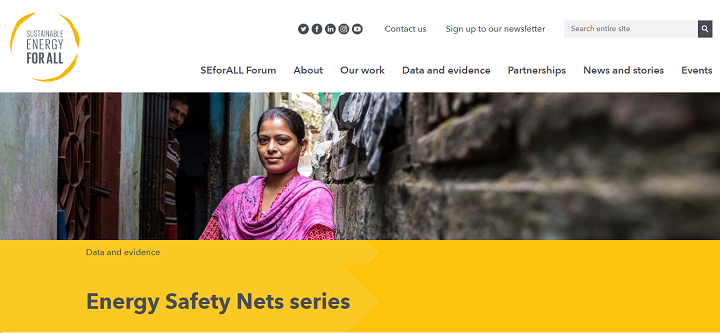Government-provided Energy Safety Nets essential to delivering universal electricity and clean cooking access
How to bring energy access to poor and disadvantaged groups is one of many challenges the world must confront to achieve Sustainable Development Goal 7 (SDG7). A new body of research by Sustainable Energy for All (SEforALL) and its key partners argues that national governments are uniquely positioned to target populations most in need of energy services and provide safety nets for those living in energy poverty.
SEforALL, the Overseas Development Institute (ODI) and the Catholic Agency for Overseas Development (CAFOD) developed Energy Safety Nets as a first-of-its-kind research series to inform best practices at the intersection of energy policy and social assistance to protect very poor, vulnerable and marginalized people.
“To achieve universal energy access, we must close the affordability gap and put the poor first. Public finance and governments play a key role in bridging this gap to connect poor and vulnerable populations to modern energy services they can afford,” said Damilola Ogunbiyi, CEO and Special Representative of the UN Secretary-General for Sustainable Energy for All and Co-Chair of UN-Energy. “Governments can use this research to inform and design effective Energy Safety Nets – helping to improve both people’s welfare and further progress on SDG7.”
Energy Safety Net is a term describing government-led approaches to support the very poor and vulnerable to access essential modern energy services (electricity and clean fuels and technology for cooking). They close the affordability gap between market prices and what poor consumers can pay for both connections and service delivery tariffs, ensuring that households or social groups are not left behind in progress to meet the SDGs.
Many countries around the world have implemented Energy Safety Nets in different forms; SEforALL and its partners examined existing approaches in Brazil, Ghana, India, Indonesia, Kenya, and Mexico to identify lessons learned and pitfalls to avoid for the sake of informing future development of Energy Safety Nets.
Insights from each of the six country case studies were compared and then synthesized into the Energy Safety Nets: Using Social Assistance Mechanisms to Close Affordability Gaps report and an accompanying guide Guide for Policymakers. This analysis revealed five main takeaways for policymakers to consider when designing their own energy-focused social assistance mechanisms. Read more about the key findings here.
Source and Image © SEforALL

